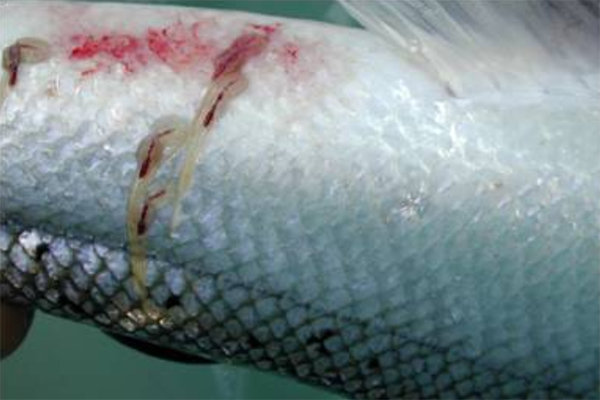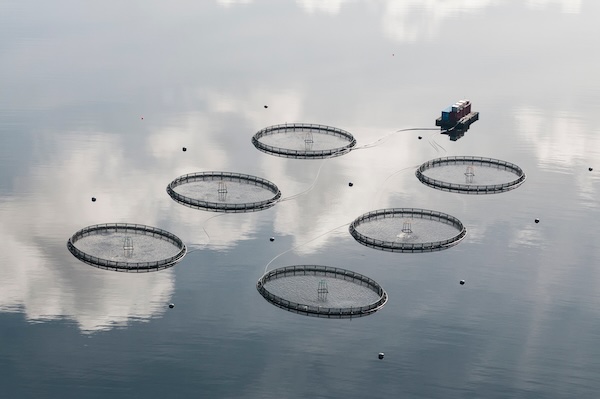EVAH’s patented in-feed treatment targets sea lice with over 99 percent efficacy, aiming to cut costs and improve fish welfare

EVAH, a Canadian biotechnology company focused on sustainable animal health, has secured a U.S. patent for a low-dosage in-feed veterinary medicinal product designed to combat sea lice – one of salmon farming’s most persistent and costly biological challenges.
“Sea lice have been a persistent, expensive, and painful challenge for too long in the farming of Atlantic salmon,” said Michel Fortin, president and CEO of EVAH. “While infestations occur naturally, the pressure on Atlantic farmed and also wild salmonids such as rainbow trout and Arctic charr has increased significantly. It’s time to offer the entire sector a solution that truly works – and it works with nature, not against it.”
Sea lice remain one of the biggest challenges in salmon farming, particularly in major production regions like Norway, Chile, Canada and the UK. Resistance to conventional treatments is rising, while alternatives like chemical baths and mechanical removal raise concerns around fish welfare and sustainability.
“The Atlantic salmon industry has reached a biological ceiling,” said Fortin. “Producers are battling the same parasite with increasingly ineffective tools. What’s needed is not just another workaround – but a real breakthrough.”
EVAH’s in-feed veterinary medicinal product offers a new approach to sea lice control, showing over 99 percent efficacy in tank studies at a low, patented dosage. It targets all parasitic stages – from juvenile to adult lice – without handling or other interventions. Delivered through medicated feed, the treatment reduces fish injuries, mortalities and stress, while supporting improved animal welfare.
Fish remain on their regular feed before and after the one-week treatment period, with medication added only during the prescribed window under veterinary supervision. Unlike existing bath or mechanical treatments – which cannot be simultaneously applied site-wide and have no duration of efficacy, often requiring repeat applications – EVAH’s solution can be applied site wide, and to multiple farms. EVAH’s in-feed solution aims to minimize fish stress, injuries and mortalities.
An in-feed solution is an alternative to conventional delousing methods like chemical treatments, physical handling, or cleaner fish – approaches that can pose challenges for fish welfare and environmental sustainability. The product is designed to minimize environmental impact, as it is not bioaccumulative and does not negatively affect fish health.
Now that you've reached the end of the article ...
… please consider supporting GSA’s mission to advance responsible seafood practices through education, advocacy and third-party assurances. The Advocate aims to document the evolution of responsible seafood practices and share the expansive knowledge of our vast network of contributors.
By becoming a Global Seafood Alliance member, you’re ensuring that all of the pre-competitive work we do through member benefits, resources and events can continue. Individual membership costs just $50 a year.
Not a GSA member? Join us.
Author
Tagged With
Related Posts

Health & Welfare
What can coho salmon teach us about sea lice resistance in Atlantic salmon?
Studying coho salmon’s sea lice resistance could lead to genetic advances to better protect Atlantic salmon, Nofima scientists say.

Health & Welfare
Tool in development aims to improve sea lice predictions and fish health
A new tool is being developed to improve sea lice predictions and enhance fish health with more reliable, consistent data.

Intelligence
SAIC funds sea lice vaccination technology developed by Stirling and other partners
The Sustainable Aquaculture Innovation Centre (SAIC) has awarded funding to assess the efficacy of novel sea lice vaccine technology.

Health & Welfare
Scientists are developing a new ‘groundbreaking’ oral vaccine for sea lice in farmed Atlantic salmon
A new oral vaccine using reverse vaccinology and artificial intelligence may help with sea lice challenges faced by the aquaculture industry.



